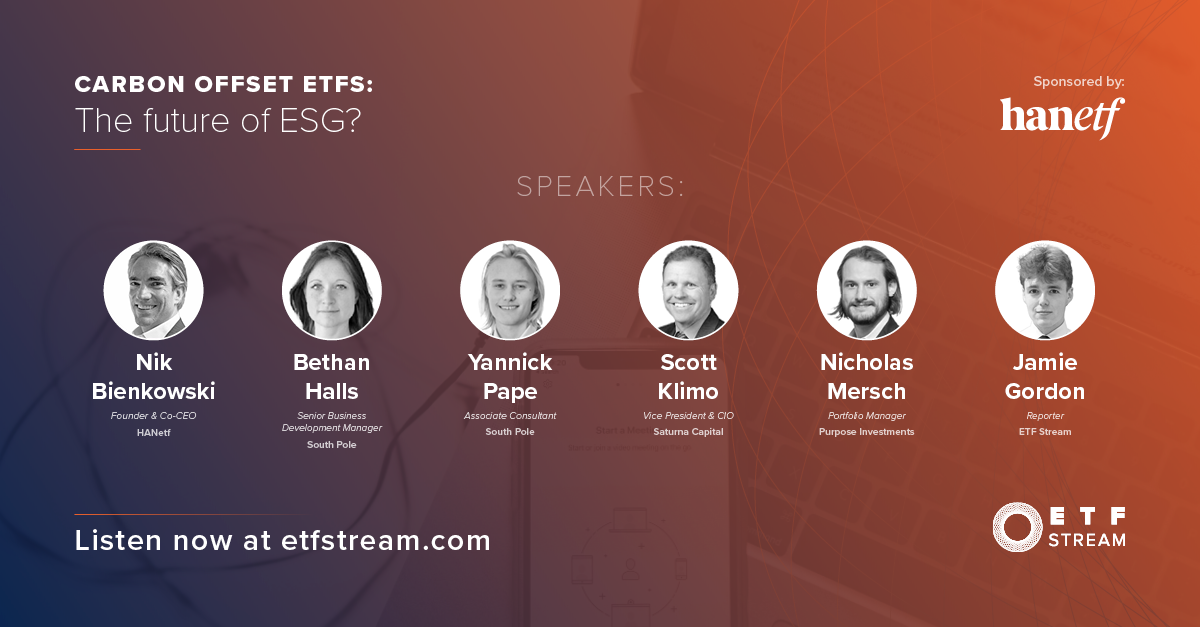The mechanics of carbon offsetting, challenges around data and where carbon offsets fit in the portfolio were the topics discussed at ETF Stream’s webinar in partnership with HANetf.
The webinar, titled Carbon offset ETFs: The future of ESG?, started by looking at why investors might turn to carbon offsetting to make their portfolio more sustainable and how it would fit in their portfolio.
Nik Bienkowski, founder and co-CEO of HANeft, said investors are attracted to carbon offsetting because they can neutralise their carbon footprint without changing their investment holdings, as they would be holding a low carbon version of the S&P 500, for example.
“Sometimes not every way is the only way. We could have used a low carbon or ESG index which sometimes involves investing in the same companies weighted by carbon intensity or ESG scores, or avoiding certain companies, but that changes your investment,” he said.
“Some investors may prefer that, but sometimes investors may decide they do not want the risk-return profile impacted materially and offsetting allows this.”
Europe’s first ETFs featuring a carbon offsetting mechanism are the HANetf S&P Global Clean Energy Select HANzero UCITS ETF (ZERO) and the Saturna Sustainable ESG Equity HANzero UCITS ETF (SESG), which both launched in July via white-label ETF issuer HANetf.
Both ZERO and SESG rely on two Verra-accredited schemes to offset their emissions, the Topaiyo forest conservation project in Papua New Guinea and the Musi River hydro plant in Sumatra, provided by offset specialist South Pole.
Scott Klimo, vice president and CIO of Saturna Capital, said while the firm takes an ‘E’, ‘S’ and ‘G’ approach to investing, it decided to launch the ETF as more time needed to be given to the environment.
“The environmental and carbon issues are existential and we need to focus on that mostly,” he said.
Bienkowski added the carbon offset projects are aligned with the United Nation’s Sustainable Development Goals (SDG), depending on where the project is based and how it is benefitted the local economy.
He said the current projects align with what HANetf believes but there was potential in the future for fund sponsors to use the offsets for specific projects.
“As long as the volume of the offsets is sufficient, we can get very specific and bespoke with particular funds. Initially, we chose projects at a high level that are also robust and verified,” he said.
Bethan Halls, senior business development manager at South Pole, added: “There are several considerations when choosing your carbon offset. For example, who your target audience is, where your investments are geographically and aligning with the values of your company, stakeholders and investors, as well as the timeframe you are investing in.”
Devil is in the data
When it comes to calculating how many carbon credits the fund needs to offset its emissions, this is either done through a third-party data provider, Refinitiv in the case of SESG, or through the index provider, S&P Global Trucost, in the case of ZERO.
S&P Global Trucost will calculate the amount of carbon tonnes per million dollars of investment the fund emits yearly and will purchase the carbon offsets from the chosen projects every quarter.
This touches upon one of the biggest challenges facing the ESG market at the moment, data. The consistency and transparency of ESG investment data across Europe is currently under the microscope with regulators circling in on providers in a bid to stamp out greenwashing.
The accuracy of companies’ emissions data reporting has also been called into question, the set of data carbon offsetting ETFs rely on to accurately offset their emissions.
While Bienkowski argued data accuracy may face challenges as the market is in its infancy, he added it can only improve as the industry grows.
“There will always be some limitations in the quality of the data but as this grows and more people realise the benefits of using carbon offsets and reporting emissions, it can only get better. Nobody is saying it is the best thing today, but the goal is to improve,” he said.
At what cost?
Yannick Pape, associate consultant at South Pole, added: “There are not only environmental and social considerations to implementing a net-zero target but also quite a strong business case by increasing your long-term competitiveness by aligning with a zero-carbon economy.”
One of the key features of the ETFs is the offsets are included in the total expense ratio (TER), alongside the administration, custody and investment management fees.
“Purpose and Saturna agreed to use the HANetf offset facility without impacting the TER and reducing their own profits on the ETFs as a result,” Bienkowski said.
He noted investors were able to buy European Union Allowances (EUA) directly to offset their portfolio, trading at around “€60-€65 per tonne” but said it was a potentially more expensive way to neutralise your portfolio.
According to Nicholas Mersch, portfolio manager at Purpose Investments, the fact the offsets are included in the TER means some sectors or themes are unviable when it comes to offsets.
“You have to have offsets in products that you can do so in a cost-effective manner,” he continued. “For example, the total cost of offsets in our products is only 0.05%, because the profile by its very nature is a clean energy fund, I do not think it makes any sense if you have an offset sleeve layered into a fossil fuel ETF or a product with a large carbon footprint because it would be far too expensive to implement from a management point of view.”
Mersch added it would not be responsible from a fiduciary perspective, while clients investing in carbon-heavy ETFs are not looking to limit their carbon footprint in the first place.
To watch the full webinar, click here.





